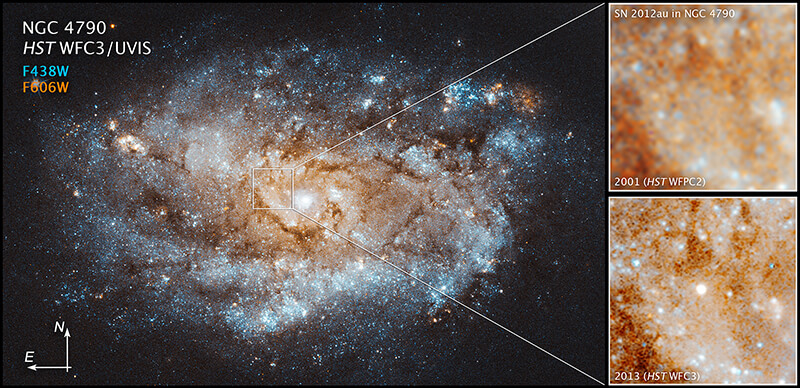September 12, 2018
Astronomers witness birth of new star from stellar explosion
 Unlike most stellar explosions that fade away, supernova SN 2012au continues to shine today thanks to a powerful new pulsar. (Photo credit: NASA, ESA, and J. DePasquale [STScI])
Download image
Unlike most stellar explosions that fade away, supernova SN 2012au continues to shine today thanks to a powerful new pulsar. (Photo credit: NASA, ESA, and J. DePasquale [STScI])
Download image
WEST LAFAYETTE, Ind. — The explosions of stars, known as supernovae, can be so bright they outshine their host galaxies. They take months or years to fade away, and sometimes, the gaseous remains of the explosion slam into hydrogen-rich gas and temporarily get bright again – but could they remain luminous without any outside interference?
That’s what Dan Milisavljevic, an assistant professor of physics and astronomy at Purdue University, believes he saw six years after “SN 2012au” exploded.
“We haven’t seen an explosion of this type, at such a late timescale, remain visible unless it had some kind of interaction with hydrogen gas left behind by the star prior to explosion,” he said. “But there’s no spectral spike of hydrogen in the data – something else was energizing this thing.”
As large stars explode, their interiors collapse down to a point at which all of their particles become neutrons. If the newly born star has a magnetic field and rotates fast enough, it can accelerate nearby charged particles and become what astronomers call a pulsar wind nebula.
This is most likely what happened to SN 2012au, according to findings published in The Astrophysical Journal Letters.
“We know that supernova explosions produce these types of rapidly rotating neutron stars, but we never saw direct evidence of it at this unique time frame,” Milisavljevic said. “This a key moment when the pulsar wind nebula is bright enough to act like a lightbulb illuminating the explosion’s outer ejecta.”
The research aligns with one of Purdue's Giant Leaps, space, which is a part of Purdue’s Sesquicentennial, 150 Years of Giant Leaps.
SN 2012au was already known to be extraordinary – and strange – in many ways. Although the explosion wasn’t bright enough to be termed a “superluminous” supernova, it was extremely energetic and long-lasting, and dimmed in a similarly slow light curve.
Milisavljevic predicts that if researchers continue to monitor the sites of extremely bright supernovae, they might see similar transformations.
“If there truly is a pulsar or magnetar wind nebula at the center of the exploded star, it could push from the inside out and even accelerate the gas,” he said. “If we return to some of these events a few years later and take careful measurements, we might observe the oxygen-rich gas racing away from the explosion even faster.”
Superluminous supernovae are a hot topic in transient astronomy. They’re potential sources of gravitational waves and black holes, and astronomers think they might be related to other kinds of explosions, like gamma ray bursts and fast radio bursts. Researchers want to understand the fundamental physics behind them, but they’re difficult to observe because they’re relatively rare and happen so far from Earth.
Only the next generation of telescopes, which astronomers have dubbed “Extremely Large Telescopes,” will have the ability to observe these events in such detail.
“This is a fundamental process in the universe. We wouldn’t be here unless this was happening,” Milisavljevic said. “Many of the elements essential to life come from supernova explosions – calcium in our bones, oxygen we breathe, iron in our blood – I think it’s crucial for us, as citizens of the universe, to understand this process.”
150 Years of Giant Leaps is yearlong celebration highlighting Purdue’s remarkable history of research and innovation, while focusing on what giant leaps Purdue can take to address the world’s problems in the areas of Space: Earth, Exploration, Economics; Artificial Intelligence, Algorithms and Automation; Health, Longevity and Quality of Life; and a Sustainable Economy and Planet. These themes will be explored even more through various Ideas Festivals, the celebration’s centerpiece event.
Writer: Kayla Zacharias, 765-494-9318, kzachar@purdue.edu
Source: Dan Milisavljevic, 765-494-3042, dmilisav@purdue.edu
Note to journalists: For a copy of the paper, please contact Kayla Zacharias, Purdue News Service, kzachar@purdue.edu
ABSTRACT
Evidence for a pulsar wind nebula in the Type Ib Peculiar supernova SN 2012au
Dan Milisavljevic, Daniel J. Patnaude, Roger A. Chevalier, John C. Raymond, Robert A. Fesen, Raffaella Margutti, Brody Conner, and John Banovetz
We present an optical spectrum of the energetic Type Ib supernova (SN) 2012au obtained at an unprecedented epoch of 6.2 years after explosion. Forbidden transition emission lines of oxygen and sulfur are detected with expansion velocities of 2300 km s-1. The lack of narrow H Balmer lines suggests that interaction with circumstellar material is not a dominant source of the observed late- time emission. We also present a deep Chandra observation that reveals no X-ray emission down to a luminosity of LX < 2 x 1038 erg s-1 (0.5–10 keV). Our findings are consistent with the notion that SN 2012au is associated with a diverse subset of SNe, including long-duration gamma-ray burst SNe and superluminous SNe, harboring pulsar/magnetar wind nebulae that influence core-collapse explosion dynamics on a wide range of energy scales. We hypothesize that these systems may all evolve into a similar late-time phase dominated by forbidden oxygen transitions, and predict that emission line widths should remain constant or broaden a few percent per year due to the acceleration of ejecta by the pulsar/magnetar bubble.

